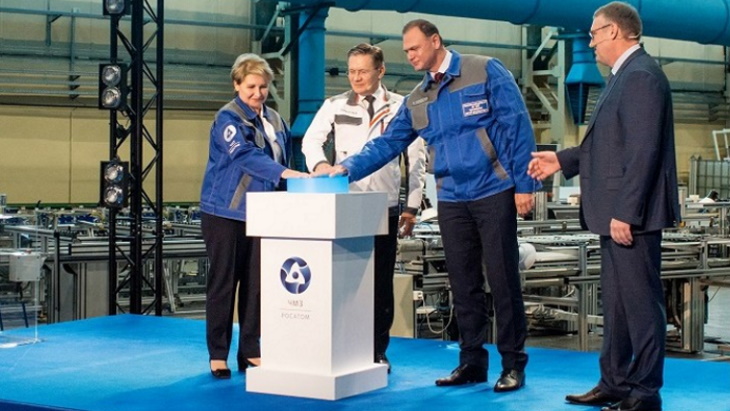Russia opens new zirconium sponge line for nuclear fuel
Russia has developed a new process line for manufacturing the zirconium sponge needed for nuclear fuel assemblies. A new facility to make the substance has been launched by Rosatom subsidiary TVEL at its Chepetsky Mechanical Plant.

Natalia Nikipelova of TVEL (left) and the head of Rosatom Alexey Likhachov (centre) were guests of honour at the ceremony (Image: Rosatom)
"The creation of our own Russian technology from scratch and the construction of a new production line is a huge achievement for our scientists and workers, a real labour feat, an important contribution to increasing our global competitiveness," said the head of TVEL, Natalia Nikipelova. She inaugurated the new zirconium sponge process line yesterday at a ceremony alongside the head of Rosatom, Alexey Likhachov.
"Zirconium sponge can be widely used in the production of fuel for all major power reactors, both Russian and foreign design," Nikipelova noted.
Chepetsky is the only plant in Russia that makes products for the nuclear industry from zirconium. The stiff, corrosion resistant metal is used to clad fuel assemblies.
Zirconium sponges are produced by injecting gas or mixing a foaming agent into molten metal, creating a froth that is stabilised by a high-temperature foaming agent, according to the Zircon Industry Association.
A key step for creation of zirconium useful in the nuclear industry is the removal of hafnium, which is difficult because it is chemically and physically similar to zirconium. At Chepetsky, a unique production facility for this was built and put into operation, TVEL said. The installation is more than 80 metres tall and includes 147 components, 2000 sensors and has a total pipeline length of over 2000 metres. "The equipment makes it possible to obtain extremely high purity zirconium tetrachloride with a hafnium content of less than 100 ppm," said TVEL.
Researched and written by World Nuclear News
- China Institute of Atomic Energy
- Nuclear Power Institute of China
- Southwestern Institute of Physics
- China Nuclear Power Operation Technology Corporation, Ltd.
- China Nuclear Power Engineering Co., Ltd.
- China Institute for Radiation Protection
- Beijing Research Institute of Uranium Geology (BRIUG)
- China Institute of Nuclear Industry Strategy (CINIS)
- China Nuclear Mining Science and Technology Corporation


